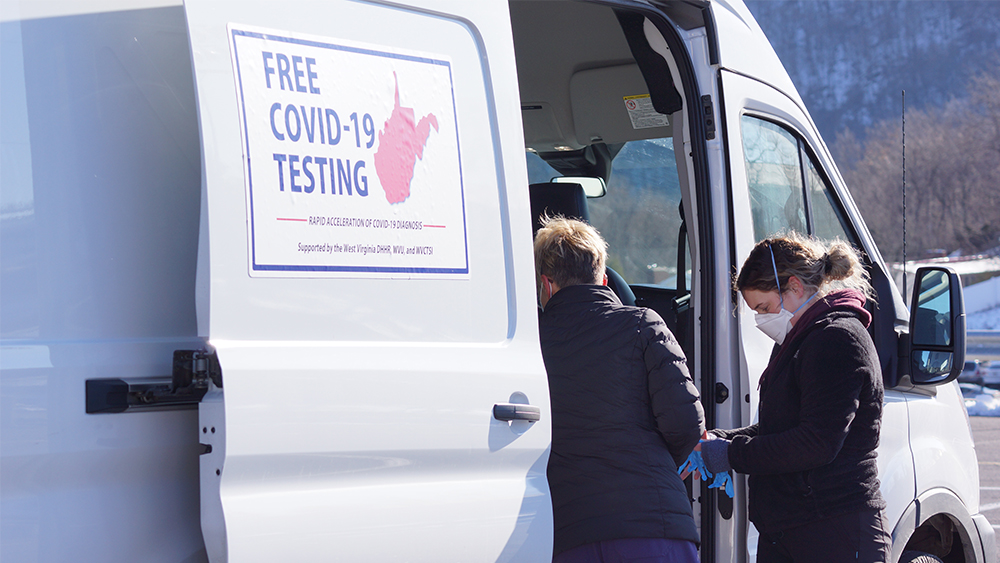Article Highlights
-
Some remote areas and communities of color in rural West Virginia have limited access to COVID-19 test sites.
-
Mobile testing vans allow trained teams to access rural areas and offer testing in COVID-19 hotspots and diverse communities that lack testing services.
-
People who test positive can take steps to protect their families and neighbors from COVID-19.
When it comes to combatting the COVID-19 pandemic, the state of West Virginia is faced with several challenges. Since many West Virginia residents live with chronic health problems,1 including heart disease and obesity, they have a particularly high risk of having severe COVID-19 symptoms and dying from the disease. Further complicating the situation, half of West Virginians live in rural areas,2 where access to healthcare may be limited.
Testing is critical to controlling the COVID-19 pandemic. But West Virginians sometimes have to travel for hours to reach COVID-19 test sites. One in five West Virginia households lives in poverty2 and lacks resources like transportation, child care, and paid time off, further reducing opportunities for COVID-19 testing.
A RADx® Underserved Populations (RADx-UP) project is breaking through barriers by bringing COVID-19 testing to hard-to-reach communities nestled in the state’s remote hills and valleys.
“If people get tested and find out that they have SARS-CoV-2 [the virus that causes COVID-19], then they can isolate themselves and stop the spread of COVID-19,” said Sally Hodder, M.D., the principal investigator of the RADx-UP project. She is also the director of the West Virginia Clinical and Translational Science Institute (WVCTSI) and the associate vice president for clinical and translational science at West Virginia University. “But, to make that possible, people need access to testing.”
WVCTSI and other state organizations are working together as never before. Using creative, flexible approaches, they are making COVID-19 testing available in remote areas, including rural African American communities.
“We’re working hard to build trust, and I believe we’re making progress.” —Sally Hodder, M.D.
Staying Ahead of COVID-19
Some West Virginia counties have adequate testing resources, but other counties have no test sites at all. To figure out where testing is most needed, WVCTSI scientists use a data system that can predict 7 to 10 days in advance where infections are likely to increase.3
“The idea is to focus testing resources in infection hotspots,” explained Stacey Whanger, M.P.H., director of the RADx-UP project. Local health departments find the most convenient sites for testing, including churches, housing developments, and health clinics, in the identified communities. Ads on social media, handouts, websites, and signs spread the word about the free testing.
“We deploy our specially equipped mobile vans and collect samples for COVID-19 testing,” Whanger said. “We help overburdened rural clinics keep up with the demand for testing wherever SARS-CoV-2 infections are likely to rise.”
The strategy is working. Just two months after the project began, the number of tests performed in participating counties jumped nearly 60%. As of January 2022, the team had collected almost 95,000 samples. One out of every eight samples tested positive, and those people were counseled to isolate to reduce the spread of COVID-19.

Project teams travel in specially equipped vans to remote areas where COVID-19 infections are predicted to rise. Photo courtesy of WVCTSI communications staff.

Project teams travel in specially equipped vans to remote areas where COVID-19 infections are predicted to rise. Photo courtesy of WVCTSI communications staff.
Reaching Communities of Color
As they began this testing initiative, the researchers realized they needed to be more creative to boost COVID-19 testing rates in West Virginia’s rural communities of color, especially among African Americans, who make up 3% to 4% of West Virginia’s population.
Nationally, African Americans have been infected at higher rates and experienced worse outcomes than whites.4 African Americans who live in small metro or rural areas are more likely to die of COVID-19 than those who live in urban areas.5,6 On top of the common barriers to COVID-19 testing in rural areas, African American communities often confront challenges related to racism, discrimination, and distrust of governmental and medical systems because of historic wrongs.7 As a result, places in West Virginia with a higher percentage of African Americans have testing rates six times lower than the state average.6
“African Americans face greater barriers to testing and have long been underserved by the healthcare system,” Hodder explained. “We provide testing for everyone, but with RADx-UP funding, we were able to obtain a dedicated mobile van to meet the testing needs of communities of color in remote areas of five counties.”
As part of their efforts to boost testing rates for rural communities of color, the researchers reached out to an organization with strong ties in the communities.
“We started working with the Partnership of African American Churches [PAAC],” Whanger said. “PAAC helped us identify prime community locations to use as test sites.” PAAC also advised the team on reaching communities of color through well-networked social institutions.
Whanger explained, “We set up rotating teams of trained, culturally competent staff who meet with African Americans where they are — churches, schools, shopping centers, colleges, social services offices — any place where community members get together.”
The mobile van goes out a few days per week to offer testing. As of January 2022 — a few months after the main mobile testing project rolled out — 1,900 tests had been done in communities of color. About 3% were positive for SARS-CoV-2. Hodder reported that more people were seeking tests when viral variants were spreading and more people were getting sick. The study team also began a home testing study that distributed testing kits to African American households.
Importantly, the team members have been learning about barriers to testing and answering people’s questions. Team members are building relationships with African American communities.
“It comes down to earning trust,” Hodder said. “We’re working hard to build trust, and I believe we’re making progress.”

Frequently Asked Questions About COVID-19 Testing
NIH provides information about the need for testing, where to get tested, types of tests, and what to do if you test positive.
Catalyzing Collaborations
To meet the demand for testing, WVCTSI researchers are working with state and local health departments, the West Virginia National Guard, the West Virginia Practice-Based Research Network, and the state’s Department of Health and Human Resources. The organizations have all offered COVID-19 testing at various times during the pandemic, but their separate efforts left gaps.
“The RADx-UP project allowed us to knit together all these pieces to create a highly effective partnership,” Hodder said. “The grant showed us what’s possible when all parties unite. We must apply this collaborative approach to other health challenges in our state, including opioid use disorder and HIV infections.”
Getting Community Buy-In
The project includes surveys to understand community attitudes toward testing. The results showed that 97% of respondents were satisfied or very satisfied with their testing experience.
Whanger told a story about a man who lived across from one of the sites where the van set up testing several times. At first, he questioned the need for testing and thought that the testing team was “trying to keep people apart.” But after a couple of weeks, he became curious about why his community was selected and why people need to get tested when infection rates seemed low.
“We explained that we were seeing signs that infections were going to rise soon, that we wanted to stop the virus from spreading,” Whanger said. “Eventually, he came to the van to get tested. By being a regular presence in the neighborhood, we were ready when he was ready.”
Sources
- Appalachian Regional Commission. (2020). Creating a Culture of Health in Appalachia: Key Findings | West Virginia. Accessed April 22, 2022, from https://www.arc.gov/wp-content/uploads/2020/07/WVHealthDisparitiesKeyFindings8-17.pdf.
- World Population Review. (n.d.). Accessed February 22, 2022, from https://worldpopulationreview.com/states/west-virginia-population.
- Price, B. S., Khodaverdi, M., Halasz, A., Hendricks, B., Kimble, W., Smith, G. S., & Hodder, S. L. (2021). Predicting increases in COVID-19 incidence to identify locations for targeted testing in West Virginia: A machine learning enhanced approach. PloS One, 16(11), e0259538. https://doi.org/10.1371/journal.pone.0259538
- Millett, G. A., Jones, A. T., Benkeser, D., Baral, S., Mercer, L., Beyrer, C., Honermann, B., Lankiewicz, E., Mena, L., Crowley, J. S., Sherwood, J., & Sullivan, P. (2020). Assessing differential impacts of COVID-19 on Black communities. Annals of Epidemiology, 47, 37–44. https://doi.org/10.1016/j.annepidem.2020.05.003
- Szabo, L., & Recht, H. (2020, April 22). The other COVID-19 risk factors: How race, income, ZIP code can influence life and death. USA Today. https://www.usatoday.com/story/news/health/2020/04/22/how-coronavirus-impacts-certain-races-income-brackets-neighborhoods/3004136001/
- Hendricks, B., Paul, R., Smith, C., Wen, S., Kimble, W., Amjad, A., Atkins, A., & Hodder, S. (2021). Coronavirus testing disparities associated with community level deprivation, racial inequalities, and food insecurity in West Virginia. Annals of Epidemiology, 59, 44–49. https://doi.org/10.1016/j.annepidem.2021.03.009
- Best, A. L., Fletcher, F. E., Kadono, M., & Warren, R. C. (2021). Institutional distrust among African Americans and building trustworthiness in the COVID-19 response: Implications for ethical public health practice. Journal of Health Care for the Poor and Underserved, 32(1), 90–98. https://doi.org/10.1353/hpu.2021.0010
Cover image: Photo of the New River Gorge, WV, courtesy of the West Virginia Department of Tourism.
 An official website of the United States government
An official website of the United States government


